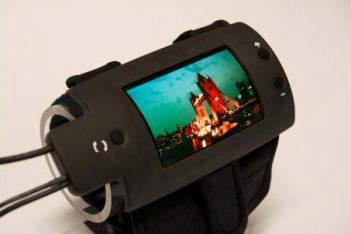There are reports that LG Display decided to built a pilot 3.5-Gen (730 Ã 460 mm) flexible OLED production line. They have ordered the equipment, which will arrive by 3Q 2012, and the line will become active by the end of 2012. An official from LGD is quoted saying that it will take 1-2 years to develop and verify the process and produce prototypes. The company hasn't decided on a production schedule yet.

LG Display's flexible OLEDs will use the same technology as Samsung's flexible prototypes - a polyimide coated substrate and direct-emission RGB sub-pixels (as opposed to LG's OLED TV which use WOLED with color filters).
LG Display already has a small flexible OLED R&D line in their Paju plant (E2). This is probably where they produced the sample a-Si 4" 100ppi (320x240) flexible panel on steel, developed in collaboration with UDC, shown above.
Back in November 2011 LG Display revealed that they are working towards plastic based OLEDs as they consider these to have the real value for the mobile solution. The idea is that the plastic will be replacing the glass cover to make the OLEDs thinner and stronger. Using plastic as the substrate to create a 'unbreakable device' as LG calls it is still several years away.
Samsung seems to be more advanced in their flexible OLED research, with mass production planned for 2012.


Flexible Amoleds will forthcoming years take oven display market from LCDs in all types of portable electronics.Flexible displays that can´t be broken and weigh just a few gram.
Weigh in portable electronics is vital for the experience of how often people will use the thing in all kinds of situations.Laptop even Intels initiative Ultrabook computers have a LCD display that also have a glass sheet.Flexible Amoleds can be made of polyamide and with TFT and electrodes for capacitive display the TFT and electrodes is best msade of graphene that is stronger than steel and transparent.
With TFT and electrodes (in x and y-coordinates) for capacitive display tech made of graphene Amoleds can be partially or totally transparent when or if the subpixels and pixels have current on or not.